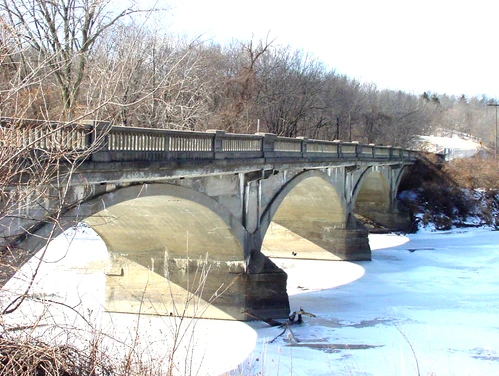- Year constructed: 1912
- Alternate name: Eureka Mill Bridge, Raccoon River Bridge
- Bridge type: Concrete Filled Spandrel Arch
- National Register of Historic Places status: Eligible
- Length: 422 feet
- Width: 20.4 feet
- Spans: 5
- FHWA: 162260
- Jurisdiction: Greene County
- Location: Old US 30 over the North Raccoon River, 2.8 miles west of Jefferson, Section 11, T83N-R31W (Jackson Township)
Details
The Eureka Mill crossing of the Raccoon River has historically been a pivotal one for Greene County. Located west of Jefferson, it linked the county seat with the town of Scranton and the entire western portion of the county and points beyond. The bridge's location, immediately upstream from a tight bend in the Raccoon River, made it difficult to maintain. The original Eureka Mill bridge was built in the 19th century, but in 1903 had to be extended by the addition of a 100-foot through truss on its east end because of flood damage to its embankment. The bridge required frequent repairs until another spring flood in 1912 destroyed its easternmost span.
Rather than repair the damage, the county board of supervisors instead opted to replace the structure entirely. The state highway commission drew plans for two bridge styles, a four-span pony truss and a five-span, concrete filled-spandrel arch structure, with massive concrete spread footings set on timber piles. The concrete bridge featured an elliptical arch profile and paneled details on the spandrels and parapets that would later become IAHC standards. With a total length of 422 feet, the proposed structure would be by far Greene County's most massive bridge. Low bidder at $13,300, the F.E. Marsh Engineering Company of Des Moines was awarded the construction contract. Marsh's crew began excavating for the foundations soon thereafter, completing the new Eureka Bridge by November.
Construction of the Eureka Bridge predated the establishment of the Lincoln Highway in Iowa, and it undoubtedly figured in the highway's routing through Greene County. Traffic on this nationally important artery had increased sufficiently by 1923 to warrant the widening of the structure's deck. That November ISHC engineers designed modifications for the bridge to increase its roadway width from 16 to 20 feet. The arches themselves remained structurally unaltered, but the bridge's original concrete deck and guardrails were removed entirely and replaced, and new paired concrete brackets were attached to the arch sidewalls to carry the wider cantilevered deck. Since the completion of this modification in 1924, the bridge has functioned essentially unaltered, although it no longer carries mainline traffic since the rerouting of U.S. Highway 30.
Numerous single-span concrete arches can be found in rural Iowa, but multiple-span examples are a relative rarity. Moreover, among those concrete arches remaining in the state, the Eureka Bridge is one of the earliest such arch structures designed by the state highway commission. Despite alterations, the Eureka Bridge appears to possess sufficient significance in its embodiment of the distinctive characteristics of a type, period or method of construction to be considered eligible under Criterion C for the NRHP.
Adapted from Fraser 1990
Areas Served
- Greene
